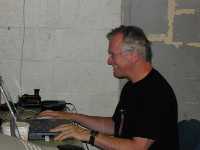 A...
A... B...
B... C...
C... D...
D... E...
E... F...
F... G....
G.... H...
H... I....
I.... J...
J... K....
K.... L...
L... M..
M.. N..
N.. O....
O.... P
P
The Crystal Face Project is an atmospheric research project funded by NASA that will take place in Key West, Florida in July of 2002. Details of this project may be found on the NASA Crystal Face Website. One of the aircraft being used is NASA's WB-57 based at Ellington Field in Houston, Texas. Over 2 dozen experiments are being integrated onto this platform. Some of these instruments are shown below. Descriptions are as follows: A) Harvard water experiment; B) HF radio for aircraft communications; C) JPL ALIAS Experiment and CU Water experiment; D) NASA ARGUS Experiment; E) NCAR NOy experiment; F) NOAA CIMS, Methane, and Ozone experiment; G) H) & I) NOAA pressure and temperature experiment; J) NOAA Frostpoint Water experiment; K) & L) DMT Particle experiment probes on the left wing pod; M) Right wing pod with experiments removed; N) Pallet area with pallets removed; O) & P) Tim and Linnea looking at some preliminary data.
 A...
A... B...
B... C...
C... D...
D... E...
E... F...
F... G....
G.... H...
H... I....
I.... J...
J... K....
K.... L...
L... M..
M.. N..
N.. O....
O.... P
P
The airplane is prepared for flight in the morning by loading all the pallets and wing pod instruments. The nose, tail, and wing hatch instruments are also loaded and checked out. The WB-57 is then rolled out of the hangar and prepared for flight. Photos A through E show various angles of the plane. Note all of the probes. Photo F shows the taxi out. Some of the particle measuring people are looking forward to flying through cirrus clouds as shown in photo G. Finally, photo H shows the take off at around 10:00 AM. Some of the people have been here since 5:00 AM so a good day's work has already been put in before the airplane is even airborne.
The test flights for the WB-57 in Houston were over, so we loaded the plane and headed to Key West, FL to start the mission with the other airplanes. The WB-57 took about 5 hours to get there. Most the rest of us had to spend the better part of a day to fly commercially. The mission is being conducted at the Naval Air Station on Boca Chica Key about 6 miles from Key West. The Navy has been gracious enough to loan us access to a hangar and accompanying office space. It only took us a few days to nest in after we arrived. However, NASA people had proceeded us and assigned space and run network drops, so that helped immensely. This project has six aircraft the NRL P3, Twin Otter operated by Cal Tech, the University of North Dakota Citation, the Proteus operated by NASA Langley , the NASA Dryden ER-2, and the NASA JSC WB-57. Photos A through I show some of the WB-57 instruments and people. Picture B shows Deedee, picture D is of Jimmie, picture E is of MJ, Picture F shows Gannet and Linnea, picture G is of Luther, and picture H is of Jess and Chris.
 A...
A... B...
B... C...
C... D...
D... E...
E... F...
F... G...
G... H...
H... I
I
All of the planes except the P3 are housed in the same hangar. Starting from the west side of the hangar in photo A is the Citation. Photo B shows the Twin Otter. Figure C shows the WB-57. Photos D, E, F, J, and K show the unusual Proteus. Photos G and H are of the ER-2 and photo I is a bird's eye view of all the planes lined up in the hangar. Photo L is a composite photo done by Dick Winkler of the Proteus. If you have a high bandwidth internet connection, click on the L itself and pan around.
 A...
A... B...
B... C...
C... D...
D... E...
E... F...
F... G...
G... H...
H... I...
I... J...
J... K...
K... L
L